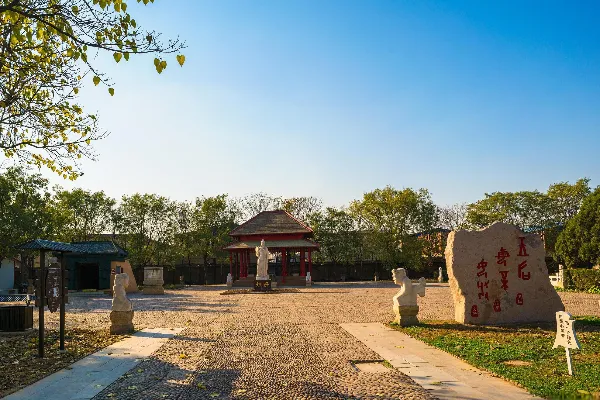
The Yinxu Scenic Area, located in Yindu District, Anyang City, Henan Province, is a national 5A-level tourist attraction and UNESCO World Heritage Site. Covering approximately 36 square kilometers (with 24 sq km core protected area), it's the first capital city site in Chinese history that has both documentary records and archaeological/oracle bone script evidence. As the late Shang Dynasty capital (c. 1300-1046 BC), Yinxu is hailed as the "Cradle of Chinese Archaeology" and was inscribed on the World Heritage List in 2006.
History and Culture
Yinxu is the ruins of the late Shang Dynasty capital (c. 1300-1046 BC), with over 3,300 years of history. Ancient texts like "Records of the Grand Historian" document that King Pangeng moved the capital here, naming it "Yin," where 8 generations of 12 kings ruled for 273 years.
In 1899, Wang Yirong discovered oracle bone script, initiating Yinxu archaeology. The 1928 scientific excavations marked the beginning of modern Chinese archaeology. Over nearly a century, Yinxu has yielded numerous precious artifacts including bronze ware, jade, and oracle bones, providing rich materials for Shang Dynasty research.
Yinxu's discovery confirmed the Shang Dynasty's existence, pushing China's documented history back nearly a millennium. The oracle bones' discovery also established China among the world's earliest civilizations with mature writing systems.
Main Attractions
Palace and Ancestral Temple Ruins
The Shang's political, military, and cultural center, with over 80 rammed-earth foundations including palaces, temples, and altars. The onsite Yinxu Museum displays many artifacts, including the famous Simuwu Ding bronze vessel.
Royal Tombs
Located north of Huan River, this noble burial ground contains 13 large tombs and 2,000 sacrificial pits. The intact tomb of Fu Hao (King Wuding's consort) yielded 1,928 artifacts - Yinxu's only well-preserved royal tomb.
Oracle Bone Script Forest
A specialized exhibit displaying hundreds of replicated oracle bones covering Shang politics, economy, military, and astronomy - a window into China's earliest mature writing system.
Chariot Pits
Over 30 excavated pits demonstrating Shang chariot burial customs, with 6 well-preserved pits showing chariot structures that prove China's early invention and use of chariots.
Featured Experiences
Oracle Bone Rubbing
Visitors can make their own oracle bone rubbing souvenirs under guidance, learning about this ancient script's production techniques.
Shang Ritual Performances
Regular recreations of 3,000-year-old court music, dance, and sacrificial ceremonies offer vivid encounters with Shang ritual culture.
Archaeology Simulation
A specially designed area where visitors use professional tools for simulated excavations under guidance, experiencing archaeologists' work.
Cuisine
Daokou Braised Chicken
An Anyang specialty - premium chicken braised with herbs and aged broth, featuring vibrant color, ingot shape, fall-off-the-bone tenderness, and unique flavor.
Anyang Triple Smoked Delicacies
Local smoked chicken, eggs, and offal using traditional methods, with reddish-brown color, rich aroma, and lingering aftertaste.
Fermented Bean Porridge
A traditional Anyang snack made from mung bean slurry, millet, soybeans, and peanuts - pleasantly sour with heat-relieving properties.
Ticket Information
Full-price: 70 yuan (covers palace and tomb sites); Half-price: 35 yuan (students/seniors over 60); Free under 1.4m. Multilingual (Chinese/English/Japanese/Korean) guided tours available by reservation.
Tour Route
Recommended itinerary: Entrance → Yinxu Museum → Palace/Temple Ruins → Oracle Bone Forest → Chariot Pits → Royal Tombs → Fu Hao Tomb → Exit (3-4 hours total).
Transportation
- Bus: Anyang city buses 1, 15, 18 etc. go directly to Yinxu
- Driving: From Beijing-Hong Kong-Macao Expressway Anyang North exit, ~20mins via Renmin Avenue
- High-speed rail: ~15min taxi from Anyang East Station
- Airplane: Nearest airport Zhengzhou Xinzheng Int'l (~1hr by high-speed rail to Anyang)
Must-Visit Attractions
- Yinxu Museum: Window into Shang civilization
- Palace/Temple Ruins: Feel the ancient capital's grandeur
- Oracle Bone Forest: Explore Chinese writing's origins
- Chariot Pits: Witness Shang chariot culture's brilliance
- Fu Hao Tomb: Visit the only intact Shang royal tomb
Tour Suggestions
- Best seasons: spring/autumn for pleasant weather
- Research Shang history beforehand for richer experience
- Allocate sufficient time for multiple exhibition halls
- Join guided tours for deeper cultural understanding
- Preserve relics - no touching exhibits
Precautions
- No smoking/open flames in ruins area
- Protect relics - no climbing on ruins/inscriptions
- Follow rules - no entering restricted areas
- Secure belongings in crowded areas
- No flash photography in exhibition halls